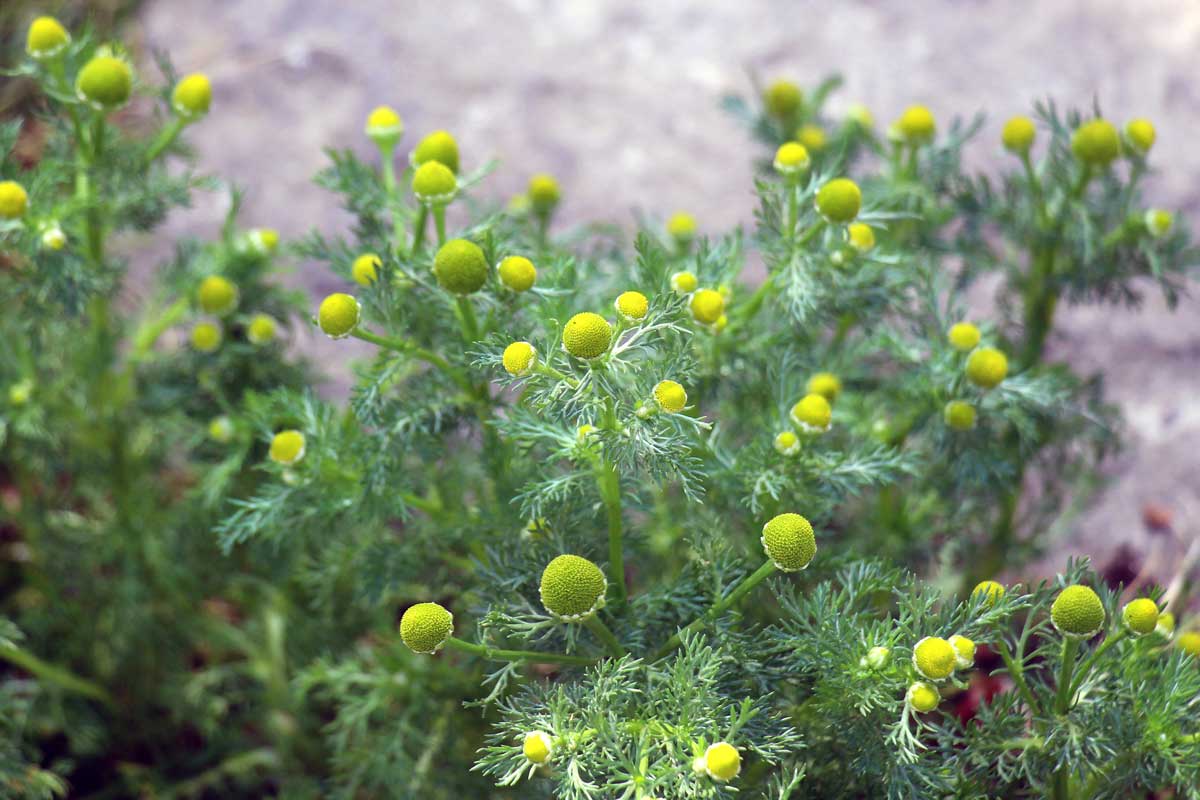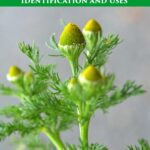Pineapple Weed (Wild Chamomile) – Identification and Uses
This post may contain affiliate links. Read my full disclosure here.
Pineapple weed is also known as wild chamomile or disc mayweed. A member of the family Asteraceae, Matricaria discoidea thrives in compacted soils and disturbed ground. It offers both beauty and utility to those who take a closer look. The fragrance is unique, and it has a long history of medicinal use.
Note: This plant is not related to Pineapple Punch Medicinal Marijuana, also known as pineapple weed, which is a Cannabis species. It is related to Matricaria recutita (German chamomile).

Table of contents
Identification Tips for Pineapple Weed (Matricaria discoidea)
Pineapple weed is a small, low-growing annual plant. It has several distinctive features that make it relatively easy to identify:
1. Leaf Shape
The leaves are finely divided and feathery, similar to those of chamomile or yarrow. They are light green and pinnately dissected, giving them a delicate, lacy appearance.
2. Flowers
The flowers are cone-shaped, yellow-green, and barely visible white petals—a defining feature. Each flower head is dome-shaped, about the size of a pencil eraser, and composed of tiny disc florets. These bloom from late spring through early fall, depending on location.

3. Fragrance
Crush the flowers or leaves, and you’ll notice a sweet, fruity aroma reminiscent of pineapple—hence the name. This pineapple scent is one of the most reliable ways to confirm your ID.
4. Growth Habit
It typically grows 6 to 12 inches tall, forming clusters in well-trodden areas like footpaths, driveways, and cracks in pavement. It is tolerant of poor, compacted, and dry soils, making it a common weed in both urban and rural settings.

Where It Grows
Pineapple weed is native to northeast Asia but has naturalized across North America and Europe. The plant grows in disturbed areas, such as roadsides, trails, garden edges, and parking lots. Its ability to grow where few other plants will makes it an important ecological pioneer species.
We had a huge area of pineapple weed growing near the barn on the farm where I grew up. It was a highly trafficked area, so I’m sure the soil was compacted. On our current homestead, it shows up near the coop or the mail box. Both areas are rough soil.

Harvesting Tips
Harvest away from roadsides or areas that may be contaminated with chemicals or heavy metals. Clip flower heads on a dry day and use them fresh or dry them for storage. Store dried pineapple weed flowers in an airtight container for up to a year.
Uses of Pineapple Weed
Despite its weedy reputation, pineapple weed is edible and medicinal, offering several benefits to foragers and herbalists. Note: Avoid if allergic to ragweed, daisies, or other Asteraceae family plants. Like all wild plants, confirm your identification before consuming, and try small amounts first to check for any sensitivities.
1. Herbal Tea
Steep the flower heads to make a mildly sweet herbal tea, similar to chamomile but with a distinctive pineapple note. Harvest pineapple weed flowers when fully formed but still greenish-yellow and aromatic. Pineapple weed tea is known for its calming, anti-anxiety, and digestive properties.
Would you like to save this?
Ingredients for Pineapple Weed Tea
- 1 to 2 teaspoons of dried pineapple weed flowers (or 1 tablespoon of fresh)
- 1 cup of boiling water
- Optional: honey, lemon, or mint for flavor
Step-by-Step Instructions
- Harvest the Flowers
Collect fresh pineapple weed flower heads (not the leaves or stems) when they are bright yellow-green and aromatic. Make sure to harvest from clean, pesticide-free areas away from roads or treated lawns. - Clean and Dry (if desired)
Rinse gently if needed, then pat dry. For dried tea, spread flowers on a screen or paper towel in a warm, dry, ventilated area for 3–5 days until crisp. - Measure the Herb
Use 1–2 teaspoons dried or 1 tablespoon fresh flower heads per cup of water. - Steep the Tea
Pour boiling water (about 200°F / 93°C) over the flowers. Cover and steep for 5–10 minutes. Longer steeping results in a stronger, slightly more bitter brew—experiment to find your preferred strength. - Strain and Serve
Strain out the solids. Add honey, lemon, or mint if desired. - Enjoy Warm or Cold
Enjoy as a warm, calming tea or refrigerate for iced tea.
2. Edible Greens
Eat young leaves raw in small amounts. Their flavor is somewhat bitter by the time the plant blooms. It’s better suited for steeping or cooking than raw consumption.
3. Medicinal Uses
Traditionally used by Indigenous peoples and herbalists to treat stomachaches, colds, fevers, and menstrual cramps. Like chamomile, it contains compounds with anti-inflammatory and mild sedative effects. Use as a topical wash for minor skin irritations or for eye compresses.
See also “Best Medicinal Herbs to Grow“.
4. Natural Bug Deterrent
Like other members of the chamomile family, pineapple weed has insect-repelling properties. The strong aroma from crushed flowers and leaves can help deter mosquitoes, flies, and some garden pests.
Rub fresh or dried plants on skin or clothing as a natural insect repellent. Do a patch test the first time you use it if you have sensitive skin, applying it to only a small area.
Pineapple Weed Bug Spray Recipe:
- Simmer a handful of fresh or dried flowers in 2 cups of water for 10–15 minutes.
- Let cool, strain, and pour into a spray bottle.
- Use on skin, clothing, or garden plants as a gentle insect deterrent.
5. Companion Planting & Soil Indicator
As a flowering plant, it provides nectar to small pollinators. While not commonly seen in garden beds, its presence indicates compacted or nutrient deficient soil. This is a cue that your soil needs improvement.
The book “When Weed Talk” notes that pineapple weed shows up when:
- Calcium is low
- Phosphorous is very low
- Potassium is very high
- Magnesium is high
- Sulfur is high
- Humus is low
- Soil is high in sand or gravel
- Soil is high in aluminum
Work to address these issues and you won’t have a problem with this plant taking over.
Learn More About Wild Medicinal and Edible Plants
We have dozens of articles about wildcrafting and foraging on the site for you to enjoy. Wild food and medicine are free and abundant – if you know where to look.
Some of our most popular articles include:
- Sweet and Aromantic Pine Cone Jam
- Harvesting and Using Dandelion Roots for Food & Medicine
- My Favorite Wildcrafting and Foraging Books

This article is written by Laurie Neverman. Laurie was raised on a small dairy farm in northwest Wisconsin, where she gathered wildflowers from the woods and pastures. She and her family now live in northeast Wisconsin, where they combine intentional plantings and semi-wild areas. Every season is a new opportunity to learn more about working with wild plants.
Originally posted in 2012, last updated in 2025.


I generally wear gloves when working in the garden due to very sensitive skin and I am intrigued that I have never had a reaction, since I may have bare hand handled it once in a while. More caution will be employed! I thought because it is so fragrant that it might be a good companion for strawberries, which it turned out not to be. It was persistent when I pulled it out, but eventually disappeared from gardened areas, which I often ponder about whether it may need a trace mineral that is easily exhausted.More points scored for Weekly Weeder!
I posted an image on another website trying to identify a weed that has taken over my neighborhood. It is believed to be pineapple weed. If it is, this weed is pure evil. I have spent 4 months with severe hives. I have about half an acre of it surrounding my house. If anyone wants some, I would send it to you except my eyes would swell shut before I could get the package sealed.
It certainly looks like pineapple weed. In terms of control, it’s a tough one. It typically occurs where the soil is compacted or there is hardpan. It’s resistant to a number of commercial herbicides. The seeds are gelatinous and will stick to clothing or fur and be easily transported to new areas. In lawns, it may be possible to crowd it out with grasses or other more desirable plants. With properly cultivated soil, it will fail to thrive. Aerating a lawn to reduce compaction would likely help eliminate it.
In a rough, rocky area like you show in your photo, I’m not sure what the best route to management might be. Maybe overseeding the area with something else that grows well there that you are not allergic to, to help crowd it out?
Thanks, Laurie. Unfortunately, crowding it out isn’t really an option. I live in the foothills north of Phoenix. Maintaining a small patch of anything takes a lot of water. I considered buying a goat as an option, but from I’ve read, they won’t even eat it.
Hmmm… maybe soil aeration? Got anyone who loves you enough to go out and poke holes in your hillside, or any burrowing critters you could encourage?
My friend, Deb, says sheep are less fussy eaters than goats, despite the reputation of goats.
Jessica I feel your pain. I live out in East Mesa and I am a AZ native and until about 2016 I really had never seen these plants around and then BAM they are everywhere. My backyard is full of them and I get the same affects that you so and NOTHING helps.
Have you had any luck with medications that have help?
This really sucks as I am the main gardener in my house and I have to have my wife go weed the yard so I can go out there and do anything at all.
It is another reason to get out of this state.
When I was a little girl, I used to stick the flowers in my nose when it was stuffy. It always seemed to work, and although it wasn’t a good idea, I never got one stuck.
I’m glad it helped, but wouldn’t generally recommend that technique.
This place is TOO COOL!! I LOVE the “Weekly Weeder” and all the information here. Have signed up for your newsletter and will be back on a regular basis to read more! Keep up the AWESOME work!!
Welcome, Jay, and thank you for your kind words. Feeling a little overwhelmed at the moment with much going on in “real life” but hope to get my online mojo back shortly and have more weedy goodness once our growing season finally gets going.
I had no idea pineapple weed could act as a natural bug deterrent and will definitely try this suggestion. I seem to attract the bug bites at family barbecues and don’t like the smell or ingredients in OTC repellents. By the way, what an excellent series.
I definitely want this series to continue!
Thanks, Michelle!
Thanks for the feature! Boy, that was one experience I hope I never have to relive.
I can imagine. Thankfully, you were able to learn from the experience.